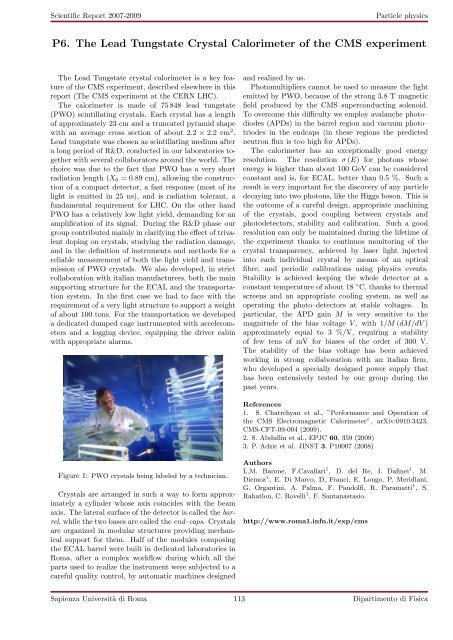download report - Sapienza
download report - Sapienza
download report - Sapienza
You also want an ePaper? Increase the reach of your titles
YUMPU automatically turns print PDFs into web optimized ePapers that Google loves.
Scientific Report 2007-2009<br />
Particle physics<br />
P6. The Lead Tungstate Crystal Calorimeter of the CMS experiment<br />
The Lead Tungstate crystal calorimeter is a key feature<br />
of the CMS experiment, described elsewhere in this<br />
<strong>report</strong> (The CMS experiment at the CERN LHC).<br />
The calorimeter is made of 75 848 lead tungstate<br />
(PWO) scintillating crystals. Each crystal has a length<br />
of approximately 23 cm and a truncated pyramid shape<br />
with an average cross section of about 2.2 × 2.2 cm 2 .<br />
Lead tungstate was chosen as scintillating medium after<br />
a long period of R&D, conducted in our laboratories together<br />
with several collaborators around the world. The<br />
choice was due to the fact that PWO has a very short<br />
radiation length (X 0 = 0.89 cm), allowing the construction<br />
of a compact detector, a fast response (most of its<br />
light is emitted in 25 ns), and is radiation tolerant, a<br />
fundamental requirement for LHC. On the other hand<br />
PWO has a relatively low light yield, demanding for an<br />
amplification of its signal. During the R&D phase our<br />
group contributed mainly in clarifying the effect of trivalent<br />
doping on crystals, studying the radiation damage,<br />
and in the definition of instruments and methods for a<br />
reliable measurement of both the light yield and transmission<br />
of PWO crystals. We also developed, in strict<br />
collaboration with italian manufacturers, both the main<br />
supporting structure for the ECAL and the transportation<br />
system. In the first case we had to face with the<br />
requirement of a very light structure to support a weight<br />
of about 100 tons. For the transportation we developed<br />
a dedicated dumped cage instrumented with accelerometers<br />
and a logging device, equipping the driver cabin<br />
with appropriate alarms.<br />
and realized by us.<br />
Photomultipliers cannot be used to measure the light<br />
emitted by PWO, because of the strong 3.8 T magnetic<br />
field produced by the CMS superconducting solenoid.<br />
To overcome this difficulty we employ avalanche photo–<br />
diodes (APDs) in the barrel region and vacuum photo–<br />
triodes in the endcaps (in these regions the predicted<br />
neutron flux is too high for APDs).<br />
The calorimeter has an exceptionally good energy<br />
resolution. The resolution σ (E) for photons whose<br />
energy is higher than about 100 GeV can be considered<br />
constant and is, for ECAL, better than 0.5 %. Such a<br />
result is very important for the discovery of any particle<br />
decaying into two photons, like the Higgs boson. This is<br />
the outcome of a careful design, appropriate machining<br />
of the crystals, good coupling between crystals and<br />
photodetectors, stability and calibration. Such a good<br />
resolution can only be maintained during the lifetime of<br />
the experiment thanks to continuos monitoring of the<br />
crystal transparency, achieved by laser light injected<br />
into each individual crystal by means of an optical<br />
fibre, and periodic calibrations using physics events.<br />
Stability is achieved keeping the whole detector at a<br />
constant temperature of about 18 ◦ C, thanks to thermal<br />
screens and an appropriate cooling system, as well as<br />
operating the photo–detectors at stable voltages. In<br />
particular, the APD gain M is very sensitive to the<br />
magnitude of the bias voltage V , with 1/M (dM/dV )<br />
approximately equal to 3 %/V, requiring a stability<br />
of few tens of mV for biases of the order of 300 V.<br />
The stability of the bias voltage has been achieved<br />
working in strong collaboration with an italian firm,<br />
who developed a specially designed power supply that<br />
has been extensively tested by our group during the<br />
past years.<br />
References<br />
1. S. Chatrchyan et al., ”Performance and Operation of<br />
the CMS Electromagnetic Calorimeter”, arXiv:0910.3423,<br />
CMS-CFT-09-004 (2009).<br />
2. S. Abdullin et al., EPJC 60, 359 (2009)<br />
3. P. Adzic et al. JINST 3, P10007 (2008)<br />
Figure 1: PWO crystals being labeled by a technician.<br />
Crystals are arranged in such a way to form approximately<br />
a cylinder whose axis coincides with the beam<br />
axis. The lateral surface of the detector is called the barrel,<br />
while the two bases are called the end–caps. Crystals<br />
are organized in modular structures providing mechanical<br />
support for them. Half of the modules composing<br />
the ECAL barrel were built in dedicated laboratories in<br />
Roma, after a complex workflow during which all the<br />
parts used to realize the instrument were subjected to a<br />
careful quality control, by automatic machines designed<br />
Authors<br />
L.M. Barone, F.Cavallari 1 , D. del Re, I. Dafinei 1 , M.<br />
Diemoz 1 , E. Di Marco, D. Franci, E. Longo, P. Meridiani,<br />
G. Organtini, A. Palma, F. Pandolfi, R. Paramatti 1 , S.<br />
Rahatlou, C. Rovelli 1 , F. Santanastasio.<br />
http://www.roma1.infn.it/exp/cms<br />
<strong>Sapienza</strong> Università di Roma 113 Dipartimento di Fisica

















